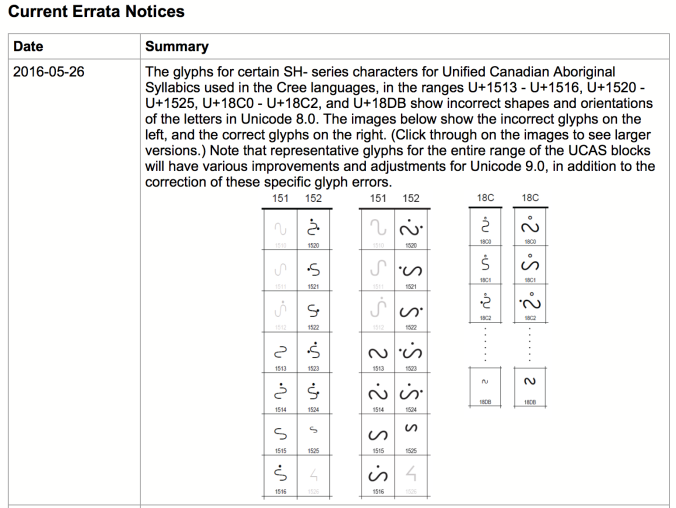When the Canadian government announced the release of the Canada 150 Typeface last year, I was immensely pleased to read that it would support Cree syllabics. In our communities, however, it is common knowledge that syllabic typefaces based on the Unicode Standard contain a number of errors in the sh-series that make typing in Cree quite a hassle. Fonts designed either locally or by linguists in the know have been used for years to circumvent this problem, but this requires that one manually change the font selected whenever typing in syllabics. Therefore, with the release of Canada 150, I immediately wanted to verify its Cree syllabics to see if the errors had been corrected.
Sadly, the errors had not been rectified and this prompted me to contact the designer of the typeface, Raymond Larabie. He was surprised to hear that the Unicode Standard contained such errors and immediately offered to help get the message across to the Unicode Consortium. We worked together to identify the erroneous glyphs and sent them examples of how the glyphs should be oriented. Eventually, the consortium replied and paid the matter the attention it deserved. A few months and emails later, the Unicode Consortium informed us that they had published a new errata notice to publicize the corrections that will take effect with the release of the Unicode Standard 9.0.
Barriers related to the use of our language need to be identified and removed if our language is to survive its uncertain future and perhaps even thrive once again. A font related problem might not seem that significant, but this little hassle has served as a disincentive for many people who would have otherwise embraced pairing our language with modern technology. I would therefore like to acknowledge and thank Debbie Anderson, Unicode Technical Director, and Raymond Larabie for their assistance in solving this problem.
It will take a while for typefaces to catch up with the corrections. In the meantime, those wishing to type in Cree can download and install the BJCree typeset provided freely here. It can be used on word processors, but not on social media. For the latter, we will simply have to be patient as we wait for the world to catch up to the Unicode Standard 9.0.
The errors and corrections can be seen below in the consortium’s latest errata notice.

Hi Kevin– what a great post! It’s wonderful that the designer was able to so effectively engage the community of Unicode designers to correct the problem; how long had you been aware of the issue beforehand?
I actually also signed up to download the Canada 150 Typeface largely because I was hoping to finally land on a reliable way to type Plains Cree syllabics (I’ve only learned a little bit of Cree) on my computer. The trouble was that I never seemed to be able to find a way to make the Plains Cree consonant endings appear (like the “ᐣ” in “ᓀᐦᐃᔭᐍᐏᐣ”). I tried a few times in the past, but couldn’t make it work, and got confused by the differences that I still didn’t/don’t understand between Plains and Eastern Cree.
I started to write this comment to ask for your help in resolving it, but I thought I’d give it one more try before hitting send– it seems like I finally made it work! If anyone else asks for your help, the Western keyboard here seems to work for me: http://www.languagegeek.com/algon/syllabics_keyboards/cr_oj_oc_na.html
final note— when you click on the ‘kepin’ in your posts, the page that comes up says “kepinomasinahikewin.wordpress.com is no longer available”
LikeLike